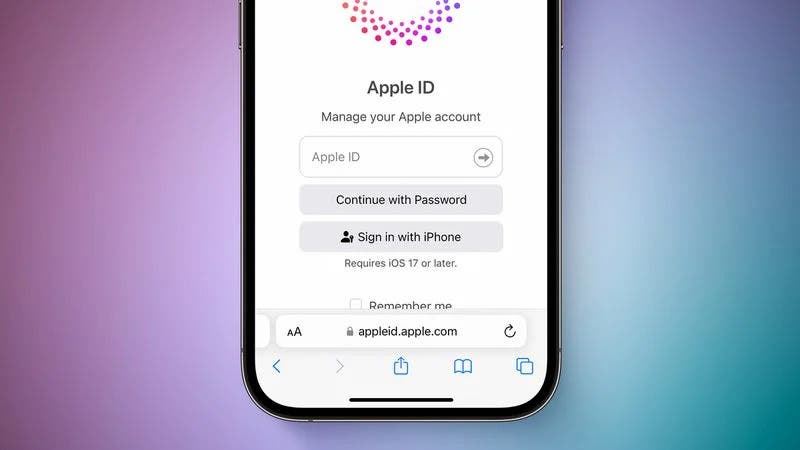Apple announced that starting from iOS 17, iPad OS 17 and macOS Sonoma, Apple ID users will automatically use Passkey to log in. After users visit icloud.com, appleid.apple.com, appstoreconnect.apple.com and other websites, Apple allows users to use Face ID or Touch ID on its login page instead of passwords. Apple officially stated that Passkey is a security solution to replace passwords. Apple’s official description is as follows:
Passkeys are invisible cryptographic entities used in place of passwords. Passkeys contain key pairs and greatly improve security compared to passwords.
One of them is a public key, registered by the website or app you are using. The other is a private key, unique to your device.
Using strong, industry-standard encryption, this key pair helps ensure a strong and private relationship between a device and a website or app.
Apple says users who upgrade to the iOS 17, iPadOS 17, and macOS Sonoma betas can test the feature on the supported Apple login page starting today. However, it is not currently available to all users.

Apple Passkey
Passkeys are a new way to sign in to websites and apps and Apple claims that it is secure and more convenient than regular passwords. Passkeys offer an extra layer of security and are designed to provide websites and apps with a passwordless sign-in experience that is both more convenient and more secure. They are built on the WebAuthentication (or “WebAuthn”) standard, which uses public key cryptography. During account registration, the operating system creates a unique cryptographic key pair to associate with an account for the app or website. These keys are generated by the device, securely and uniquely, for every account.
How to enable passkeys
With passkey support, users’ Apple IDs are automatically assigned a passkey that can be utilized for authentication on Apple and iCloud domains. To enable passkeys, users need to update their devices to iOS 17, iPadOS 17, or macOS Sonoma. Once updated, users can enable passkeys by following these steps:
- Open Settings on your device.
- Tap on Passwords & Accounts.
- Tap on the option for Security.
- Select the option for Passkeys.
- Follow the prompts to set up your passkey.
The benefits of passkeys
Passkeys are faster to sign in with, easier to use, and much more secure than traditional passwords. Here are some of the benefits of using passkeys:
More secure
Passkeys are resistant to phishing, always strong, and designed so that there are no shared secrets. This makes passkeys very strong, easy – to – use credentials that are highly phishing – resistant. And platform vendors have worked together within the FIDO Alliance to make sure that passkey implementations are compatible cross-platform and can work on as many devices as possible.
Easier to use
Passkeys are easier to use than regular passwords. They are linked only with the website or app they were created for, thereby protecting you from getting tricked into using a passkey to sign in to a fraudulent website or app. Your device stores the passkey in iCloud Keychain, so it’s available on all your devices where you’re signed in with your Apple ID.
Passwordless sign-in
Passkeys provide websites and apps with a passwordless sign-in experience that is both more convenient and more secure. With passkeys, users no longer have to remember complex passwords or worry about their passwords being stolen or hacked.

Cons of Passkey
The passkey is a newer method of account security that uses a physical device, such as a USB key, to verify the user’s identity. Though newer, it still comes with its cons like every other tech product. Passkeys provide an additional layer of security. Here are some cons to using passkeys
- Costly: Passkeys can be more expensive than passwords, especially if they are lost or damaged and need to be replaced
- Incompatible: Some systems may not be compatible with the passkey. This will make it hard for people to use them across multiple platforms
- Less convenient: Passkeys require the user to have the physical device with them in order to access their account. This can be less convenient than simply recalling a password
- Compromised if the device is stolen or hacked: If a user’s device is stolen or hacked, their passkey could be compromised
- Limited adoption: Passkeys are a newer tech and may not be widely adopted yet, making it difficult to use them for all accounts.
The decision between passwords and passkeys comes down to personal preference. It also depends on the level of security that the user needs for the account. For high – security accounts, such as banking or financial accounts, it may be worth using passkeys despite their cons. However, for less sensitive accounts, passwords may be just enough and more convenient to use.
How secure are passkeys compared to passwords?
Passkeys are much more secure than traditional passwords. Passkeys are resistant to phishing, always strong, and designed so that there are no shared secrets. This makes passkeys very strong, easy-to-use credentials that are highly phishing-resistant. And platform vendors have worked together within the FIDO Alliance to make sure that passkey implementations are compatible cross-platform. They are also making sure that they can work on as many devices as possible.
In contrast, traditional passwords are often weak and easy to guess or hack. They are also exposed to phishing attacks. Hackers easily trick users with passwords into revealing their info by posing as a legit website or app.
Conclusion
Passkeys are a new way to sign-in to websites and apps that are both more secure and easy to use. With passkey support coming to iOS 17, iPadOS 17, and macOS Sonoma, users will be able to enjoy a passwordless sign-in experience. Apple says that this new sign-in method is more secure and easy to use. To enable passkeys, users need to update their devices to the latest operating systems.





